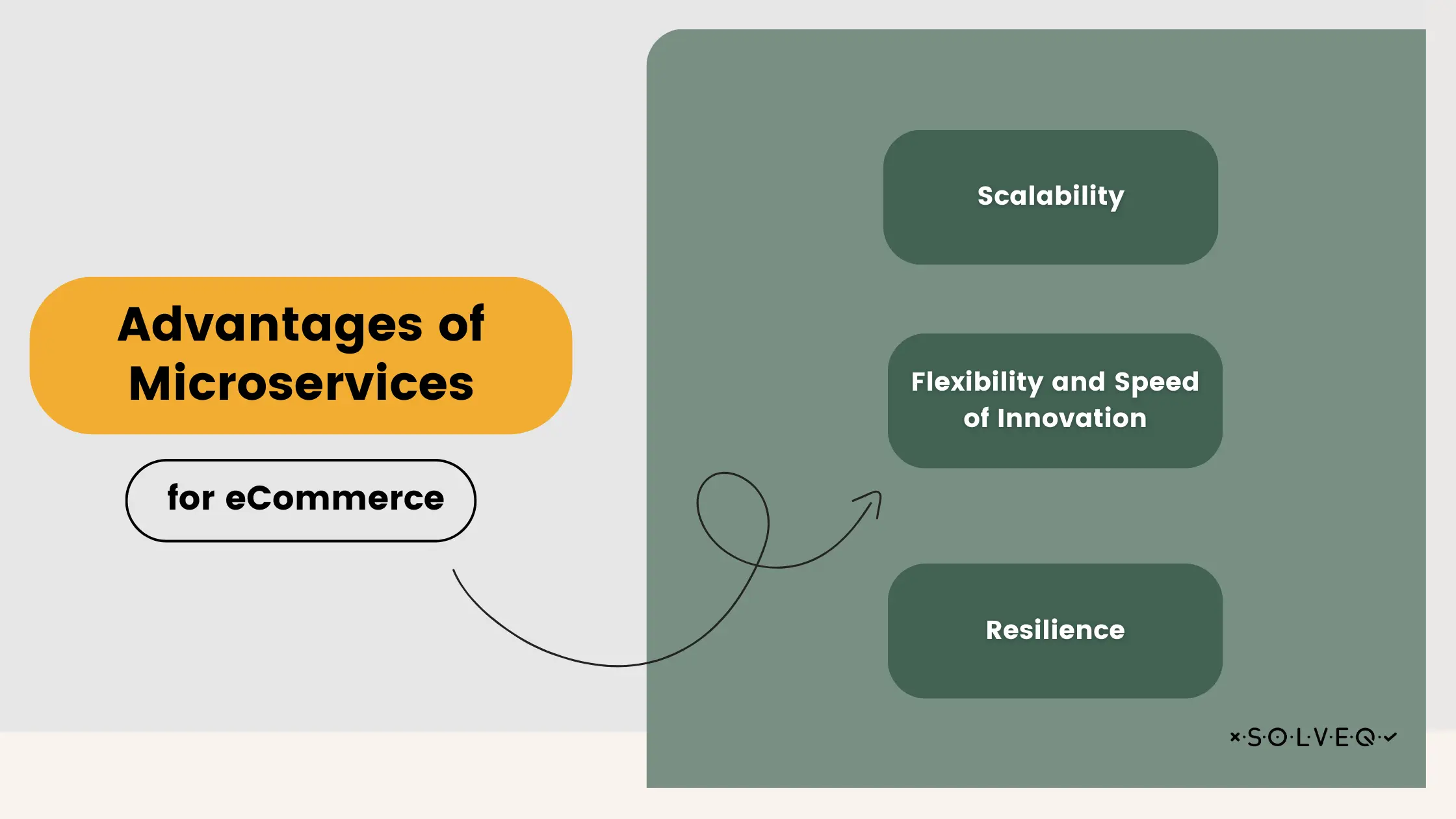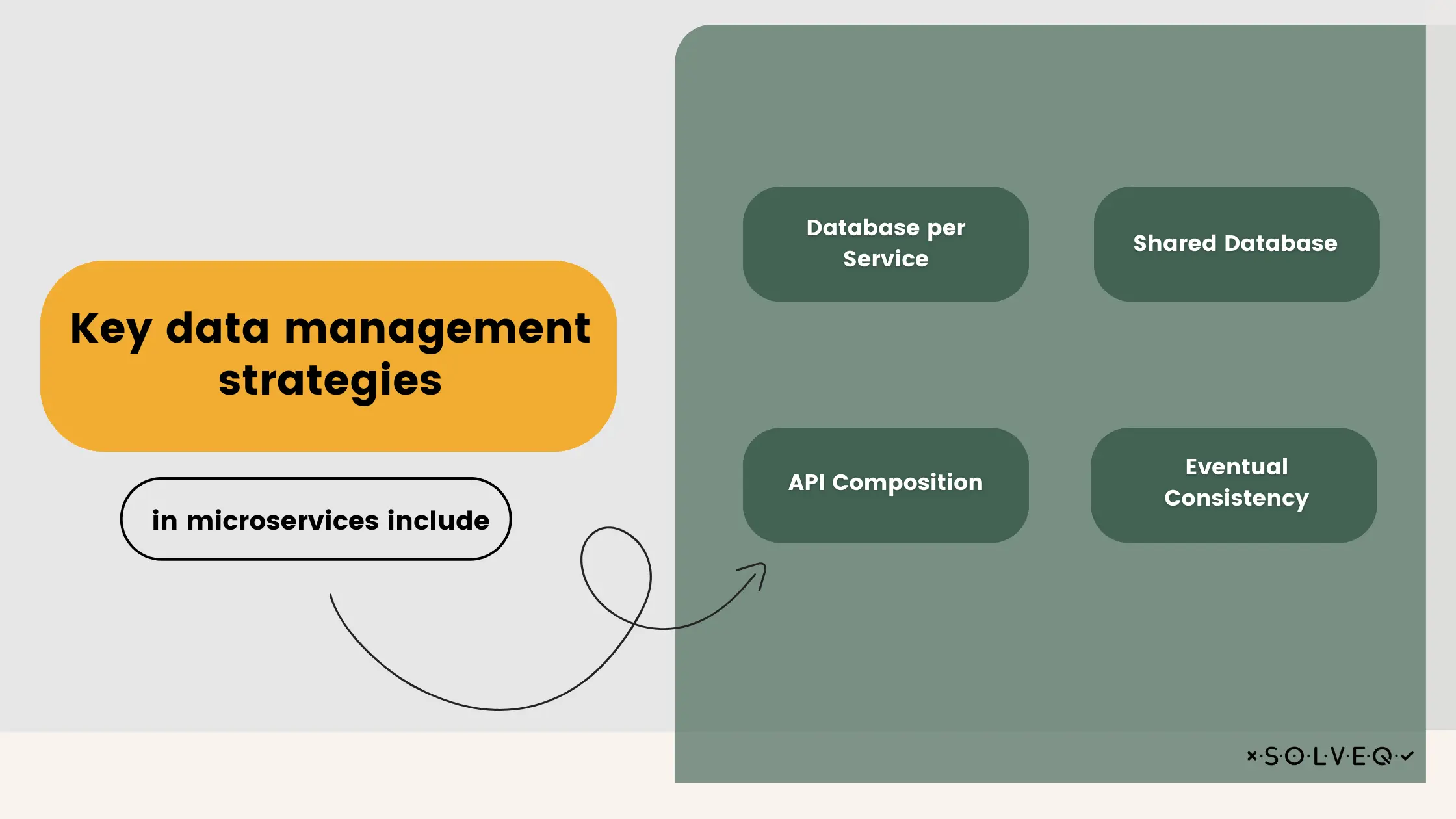Microservices Magic: How to Build Scalable and Flexible eCommerce Systems
4 Apr 2024 • 22 min read

Marcin Kulawik

In the dynamic world of online commerce, microservices have emerged as a key architectural style, revolutionizing how eCommerce systems are designed and operated. This approach involves breaking down an application into a suite of small, independent services, each running in its own process and communicating via lightweight mechanisms.
The adoption of microservices in eCommerce brings notable benefits, including enhanced scalability to handle fluctuating traffic, increased flexibility for rapid adaptation to market demands, and faster deployment times for new features and updates. These advantages make microservices a compelling choice for eCommerce businesses seeking to stay agile and competitive in a fast-paced industry. The following sections delve deeper into the intricacies of microservices, covering everything from their basic components and implementation to future trends and innovations.
Understanding Microservices
Microservices are an architectural approach in software development where a single application is structured as a collection of loosely coupled services. Each service in a microservices architecture is a self-contained unit, handling a specific business function and communicating with other services via well-defined APIs. This stands in stark contrast to the traditional monolithic architecture where all components of an application are interwoven and deployed as a single unit.
One of the key characteristics of microservices is their granular scalability. In a monolithic architecture, scaling often means replicating the entire application, which can be resource-intensive. In contrast, microservices allow for individual components to be scaled independently, leading to more efficient resource utilization. This modular nature also promotes a more agile development and deployment process, as teams can work on different services simultaneously and deploy them independently.
Advantages for eCommerce
E-commerce platforms can significantly benefit from adopting a microservices architecture, mainly due to its scalability, flexibility, and resilience. These benefits are critical in the dynamic and highly competitive world of online retail.

- Scalability: E-commerce websites often experience variable traffic, with spikes during sales, holidays, or special promotions. Microservices allow for scaling specific functions of the platform (like payment processing or inventory management) independently to handle increased load, without impacting the entire system.
- Flexibility and Speed of Innovation: Microservices enable quicker implementation of new features or updates, as changes can be made to a single service without disrupting the entire system. This agility is essential for e-commerce platforms that need to rapidly adapt to market trends, customer preferences, and technological advancements.
- Resilience: Microservices enhance the overall resilience of e-commerce platforms. In a microservices architecture, if one service fails, it doesn't necessarily bring down the entire application. This isolated failure management is crucial for maintaining uptime and ensuring a consistent user experience, which is vital for customer retention and trust in an e-commerce context.
Use Cases
Several leading e-commerce businesses have leveraged microservices to drive growth and improve customer experience.
- Amazon: One of the earliest adopters, Amazon transformed from a monolithic to a microservices architecture. This change was pivotal in allowing Amazon to scale efficiently, leading to improved website performance and the ability to rapidly innovate and deploy new features.
- eBay: eBay migrated to a microservices architecture to manage its massive inventory and user base more effectively. This shift allowed for more agile development cycles and better handling of the diverse range of products and services offered on their platform.
- Netflix: While not a traditional e-commerce platform, Netflix’s adoption of microservices for its streaming service demonstrates the architecture's scalability and resilience benefits. The ability to manage large volumes of content and provide a seamless streaming experience has parallels in managing e-commerce inventories and customer interactions.
These examples underscore the transformative impact of microservices in the e-commerce sector, highlighting the architecture's role in supporting scalability, enabling rapid innovation, and ensuring a resilient and responsive platform.
Architectural Components of Microservices in eCommerce
In the intricate world of eCommerce, the architecture of microservices plays a pivotal role in ensuring that online platforms are both scalable and maintain high-performance standards. This section delves into the key components that form the backbone of a robust microservices architecture in an eCommerce setting.
Service Discovery
In a microservices architecture, service discovery is essential in managing service communication dynamically. It's how services in a microservices environment locate and communicate with each other. As each service operates independently, an efficient method for services to identify and interact with other service network locations is crucial.
There are two main types of service discovery: client-side and server-side. In client-side discovery, the service client itself is responsible for finding available service instances and routing its request. In server-side discovery, a central server, often known as a service registry, keeps track of all service instances and routes client requests accordingly.
Effective service discovery in eCommerce platforms ensures seamless interconnectivity and functioning of various components like product catalogs, customer databases, and payment systems, especially critical during peak traffic periods.
API Gateway
The API Gateway is a vital component in a microservices architecture, serving as the single entry point for all client requests. It provides a unified interface to various services, simplifying client interaction with the system. This setup enables clients to send requests to one endpoint instead of managing multiple microservices separately.
For eCommerce platforms, the API Gateway is crucial. It manages requests related to product information, user accounts, order processing, etc., and directs them to the appropriate microservices. It also addresses cross-cutting concerns like authentication, SSL termination, and rate limiting, securing and optimizing client-service interactions.
Data Management
Data management in a microservices architecture, particularly in eCommerce, is challenging due to the need for consistency and real-time data processing. Microservices often use separate databases to ensure loose coupling and service independence, contrasting with the single database in monolithic applications.

Key data management strategies in microservices include:
- Database per Service: Each microservice has its database, enhancing autonomy but requiring careful management of data consistency.
- Shared Database: This approach eases data management and ensures consistency but can lead to tight coupling of services.
- API Composition: Services interact through APIs for data retrieval or updates, maintaining independence while facilitating data sharing.
- Eventual Consistency: Instead of immediate consistency, microservices may use eventual consistency, where data updates become consistent over time, not instantly.
In eCommerce systems, these strategies must balance rapid, consistent data access (like inventory levels and customer preferences) with the flexibility and resilience of a microservices architecture. The strategy choice often depends on specific business needs and the trade-offs an organization is prepared to accept.
Building Blocks for Microservices in eCommerce
The effectiveness of a microservices architecture in eCommerce largely hinges on the technologies and practices adopted for deployment and updates. Two pivotal components in this realm are containers with orchestration tools, and continuous integration/continuous deployment (CI/CD) practices.
Containers and Orchestration
Containers, like those provided by Docker, are a cornerstone of microservices in eCommerce. They encapsulate a microservice and its dependencies into a single, executable package, ensuring consistency across different environments. This uniformity is crucial for eCommerce platforms, where microservices must operate reliably whether in development, testing, or production.
Orchestration tools, with Kubernetes being a prime example, manage these containers at scale. In an eCommerce context, where numerous microservices need to be deployed, scaled, and maintained, orchestration tools are invaluable. They automate various tasks, such as load balancing, scaling services up or down based on demand, and ensuring high availability, which are all critical for maintaining a seamless online shopping experience.
Continuous Integration/Continuous Deployment (CI/CD)
CI/CD pipelines are integral to microservices architectures, especially in the fast-paced environment of eCommerce. Continuous Integration (CI) involves merging all developers' working copies to a shared mainline several times a day. This process significantly reduces integration problems, which is a key challenge in developing complex systems like eCommerce platforms.
Continuous Deployment (CD), on the other hand, is about automating the software release process. The idea is to release new changes to customers quickly and sustainably. In an eCommerce setting, this means new features, updates, or bug fixes can be deployed rapidly and reliably, enhancing the customer experience and keeping the platform competitive.
The combination of CI/CD ensures that software updates are less risky and can be delivered more frequently. This capability is crucial in eCommerce, where staying ahead with the latest features, security patches, and performance enhancements directly translates to improved user experience and, ultimately, business success.

Challenges and Solutions in Microservices for eCommerce
While microservices offer numerous benefits for eCommerce platforms, they also bring a unique set of challenges. Addressing these effectively is crucial for leveraging the full potential of a microservices architecture.
Handling Complexity
The shift from a monolithic to a microservices architecture inherently increases complexity. This complexity arises in managing multiple, independently deployable components, ensuring their seamless integration, and maintaining overall system stability. In eCommerce, where uptime and user experience are paramount, this complexity can be particularly daunting.
Solution: Adopting robust monitoring and management tools is crucial. These tools help in visualizing the system’s architecture, monitoring service health, and quickly identifying and resolving issues. Additionally, a well-defined organizational structure, where teams are aligned with specific microservices, can help manage this complexity effectively.
Inter-Service Communication
Ensuring efficient communication between services is a significant challenge in microservices architectures. In eCommerce, where different services (like inventory management, order processing, and payment systems) need to interact constantly, inefficient communication can lead to delays and inconsistencies.
Solution: Implementing asynchronous messaging systems, such as message queues or event buses, can greatly enhance inter-service communication. These systems enable services to communicate without waiting for responses, thereby reducing latency and improving overall system responsiveness.
Security Concerns
Security in a distributed system like microservices is complex and multifaceted. In an eCommerce context, where sensitive customer data is handled, maintaining robust security is non-negotiable.
- API Security: Ensuring that APIs are secure is critical as they are the primary means of communication between services. Techniques such as API gateways, rate limiting, and API tokens can help mitigate security risks.
- Service-to-Service Authentication: In microservices, each service should authenticate itself to communicate with other services. Implementing service-to-service authentication protocols, such as OAuth or mutual TLS, can help secure inter-service communication.
- Data Encryption: Protecting sensitive data both in transit and at rest is paramount. Utilizing strong encryption protocols for data being transferred between services and encrypting sensitive data stored in databases are essential practices in securing an eCommerce microservices architecture.
Tackling these challenges effectively is essential for building a resilient, scalable, and secure eCommerce platform using microservices. Each solution should be tailored to the specific needs and context of the eCommerce platform, ensuring a balanced approach between operational efficiency and robust security.
Implementing Microservices in eCommerce
Adopting a microservices architecture in an existing eCommerce platform requires careful planning and strategy. The transition should be systematic and thoughtful to minimize disruption and maximize benefits.

Planning and Strategy
- Assess Current Architecture: Begin with a thorough assessment of your current monolithic architecture. Identify the components that would benefit most from being broken down into microservices.
- Define Business Objectives: Clearly define what you aim to achieve with microservices - be it scalability, agility, improved customer experience, or all of these.
- Start Small: Don’t attempt to rearchitect everything at once. Start with a small, non-critical part of your system that can be easily isolated.
- Build a Cross-Functional Team: Form a team that includes members with diverse skills - developers, operations, QA, and others. Microservices require a collaborative approach.
- Iterative Development: Adopt an iterative approach to development. Continuously test and get feedback on each microservice, and iterate before moving on to the next.
- Implement a DevOps Culture: Encourage a DevOps culture that fosters collaboration between development and operations, facilitating continuous integration and deployment.
- Train Your Team: Ensure your team is adequately trained in the new technologies and methodologies that microservices require.
- Plan for Long-Term Maintenance: Prepare for the long-term implications of maintaining multiple microservices, including monitoring, updating, and troubleshooting.
Choosing the Right Tools
- Development Frameworks: Choose frameworks that support microservice architectures. For example, Spring Boot for Java, Express.js for Node.js, and Flask for Python are popular choices.
- Containerization: Docker is widely used for containerizing microservices, making them portable and easy to deploy.
- Orchestration: Kubernetes is a leading tool for orchestrating containerized applications, providing scalability and automated deployment.
- API Gateway: Consider using an API gateway like Kong or Apigee to manage and secure microservice APIs.
- Service Mesh: Tools like Istio or Linkerd can be used to manage service-to-service communications efficiently and securely.
- Database Management: Depending on your needs, use databases that support microservices patterns, like NoSQL databases (e.g., MongoDB, Cassandra) or cloud-native databases.
- Monitoring and Logging: Implement robust monitoring and logging tools like Prometheus for monitoring and ELK Stack (Elasticsearch, Logstash, Kibana) for logging.
Selecting the right set of tools is crucial as it impacts the development, deployment, and maintenance of microservices in an eCommerce context. The choice should align with your business objectives, existing infrastructure, and team expertise. Transitioning to a microservices architecture is not just a technical change but a strategic business decision that can significantly impact your eCommerce platform's scalability, flexibility, and overall success.
Future Trends and Innovations in Microservices for eCommerce
The landscape of microservices in eCommerce is continuously evolving, driven by emerging technologies and innovative approaches. Two notable trends poised to shape the future are serverless architectures and AI-driven service optimization.
Serverless Architectures
Serverless computing is a cloud-computing execution model where the cloud provider dynamically manages the allocation and provisioning of servers. In the context of microservices, serverless architectures allow individual services to be hosted without the need for managing the underlying infrastructure.
For eCommerce platforms, serverless architectures can bring significant benefits:
- Cost Efficiency: You pay only for the resources your services consume, which can be more cost-effective than maintaining servers.
- Scalability: Serverless architectures can automatically scale up or down based on demand, ideal for handling the fluctuating traffic of eCommerce sites.
- Faster Time-to-Market: It allows developers to focus on building functionalities without worrying about the server setup, leading to quicker deployment of new features or services.

AI-Driven Service Optimization
Artificial Intelligence (AI) is increasingly being integrated into microservices to enhance their performance and efficiency. AI-driven service optimization in eCommerce can manifest in several ways:
- Predictive Scaling: Using AI to analyze traffic patterns and predictively scale services in anticipation of traffic spikes, preventing performance bottlenecks.
- Personalization: AI can help in creating more personalized user experiences. For instance, microservices can use AI algorithms to provide personalized product recommendations based on user behavior.
- Automated Issue Resolution: AI can aid in monitoring microservices, predicting potential issues, and even automatically resolving common problems.
The integration of AI into microservices promises not only to improve operational efficiencies but also to enhance customer experiences significantly. By leveraging AI, eCommerce platforms can deliver more intuitive and responsive services, which is key to customer retention and satisfaction.
As these trends continue to evolve, they hold the potential to drastically transform how microservices are used and managed in eCommerce. They signify a move towards more efficient, cost-effective, and customer-centric eCommerce experiences. Keeping abreast of these trends and innovations is essential for eCommerce businesses looking to leverage microservices for strategic advantage.
Summary
Microservices architecture marks a significant shift in designing and operating eCommerce systems, bringing scalability, flexibility, and faster deployment to the forefront of digital commerce. Through a deep dive into its various components and practices, we've seen how it addresses the unique demands of online retail, from managing intricate service communications to ensuring robust security. The exploration of future trends like serverless computing and AI optimization further highlights the evolving potential of microservices in refining eCommerce experiences. As the digital marketplace continues to expand and evolve, embracing microservices can be a key strategy for businesses aiming to stay agile and customer-focused. For those looking to harness these benefits, the journey into microservices architecture could be the next pivotal step in your eCommerce evolution.
Share:
Looking for expert development team?
Schedule a call with Tech Consultant

Marcin Kulawik
Founder and CEO of SolveQ. Huge fan of building things with purpose, agility, and having fun while changing the World. Loves his family, teammates, and nature.